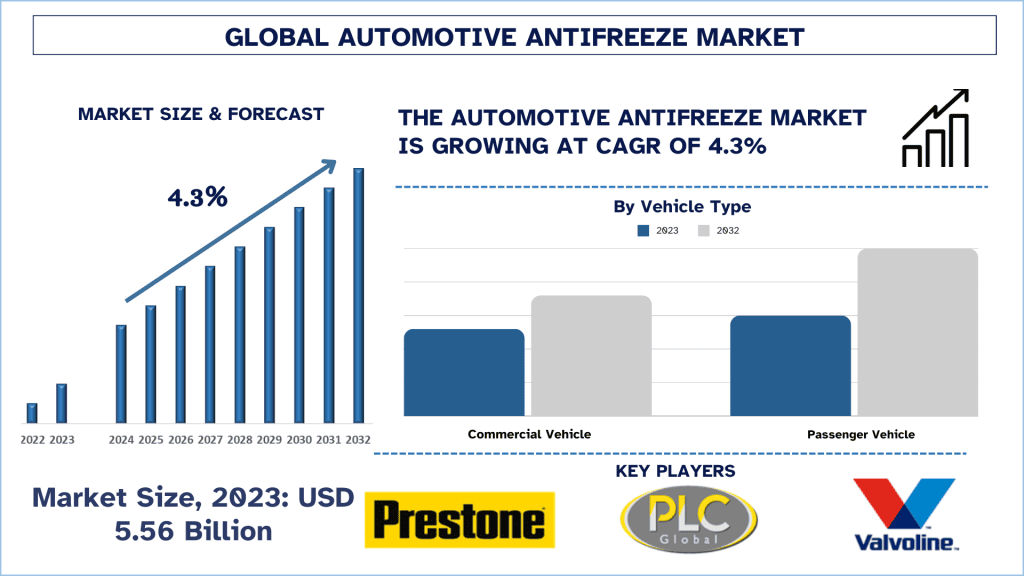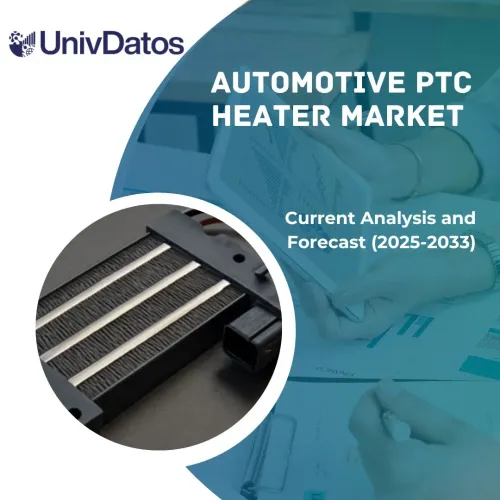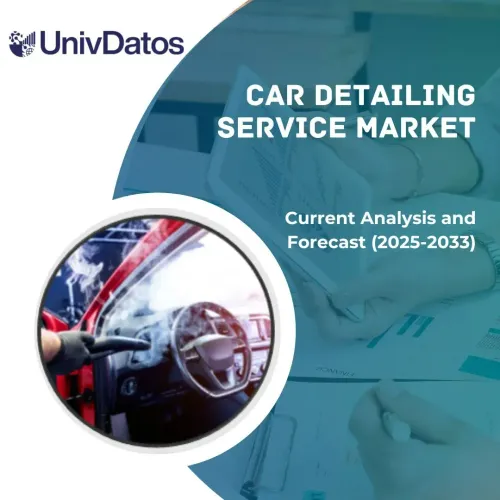자동차 부동액 시장 규모 및 예측
자동차 부동액 시장은 2023년에 55억 6천만 달러로 평가되었으며, 예측 기간 (2024-2032) 동안 약 4.3%의 견조한 연평균 성장률(CAGR)을 보일 것으로 예상됩니다.
자동차 부동액 시장 분석
자동차 부동액 시장은 글로벌 자동차 산업의 중요한 부분이며, 그 성장은 다음의 확장에 밀접하게 연관되어 있습니다.자동차부문. 에 대한 수요가차량계속 증가함에 따라 엔진과 냉각 시스템을 효과적으로 보호할 수 있는 부동액 솔루션의 필요성이 점점 더 중요해지고 있습니다.
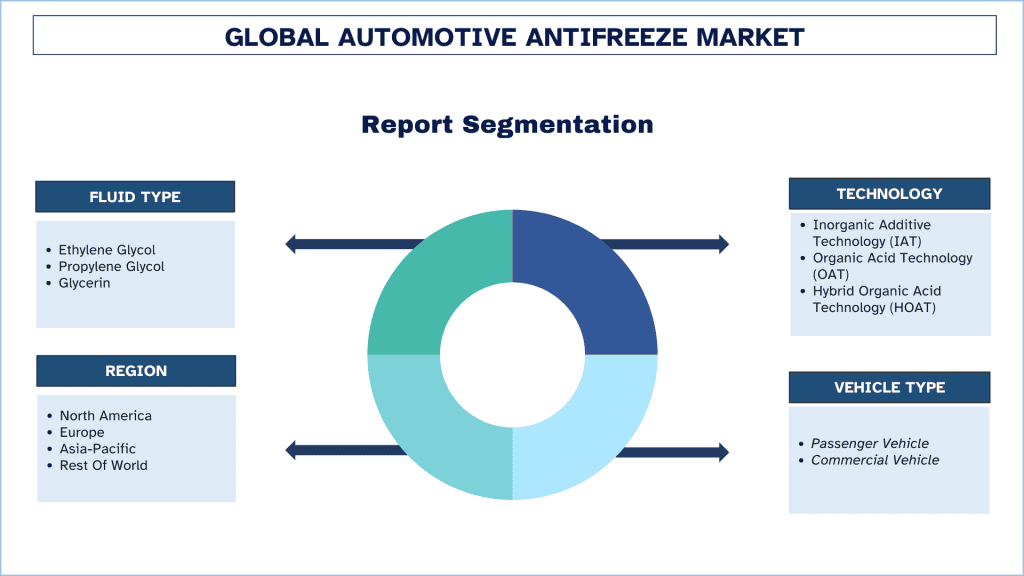
자동차 부동액 시장 동향
현재, 자동차 부동액 시장은 그 발전을 정의하고 더 나아가 진전을 이루는 몇 가지 추세를 경험하고 있습니다. 한 가지 관찰된 추세는 시장에서 더 친환경적인 부동액 제품이 등장하고 사용되고 있다는 것입니다. 부동액 솔루션의 준비는 현재 제조업체에게 가장 중요한 문제 중 하나이며, 환경에 미치는 영향이 적고, 감독 법규 요구 사항을 충족하며, 생분해성을 입증하는 제품을 개발하고자 합니다. 그들은 환경 문제에 대한 고객의 인식 증가와 자동차 유체의 환경 영향 억제를 위한 법적 조치에 의해 움직였습니다. 또 다른 중요한 움직임은 장수명, 고성능 부동액 제품의 개발입니다. 이러한 제품의 주요 응용 분야는 '더 긴 오일 교환 주기, 뛰어난 부식 방지 및 첨단 엔진과의 호환성'을 제공하는 것입니다. 이러한 더 높은 형태의 제품에 대한 필요성은 특히 성능 및 상업용 차량에서 일관되고 효율적인 엔진과 낮은 유지 관리 비용에 대한 수요로부터 인식됩니다.
A또한 전기차와 하이브리드차도 다른 유형의 부동액 냉각수를 필요로 하기 때문에 부동액 시장에 영향을 미치고 있습니다. 이러한 차량의 배터리 및 전기 모터로 인해 특수한 유형의 냉각이 필요하므로 전기차(EV)용 부동액이 다른 유형으로 만들어집니다. EV 사용은 향후 증가할 것으로 예상되므로 이 추세가 성장하고 있으며, 이에 따라 부동액 제조에 대한 기회와 위협이 있습니다.
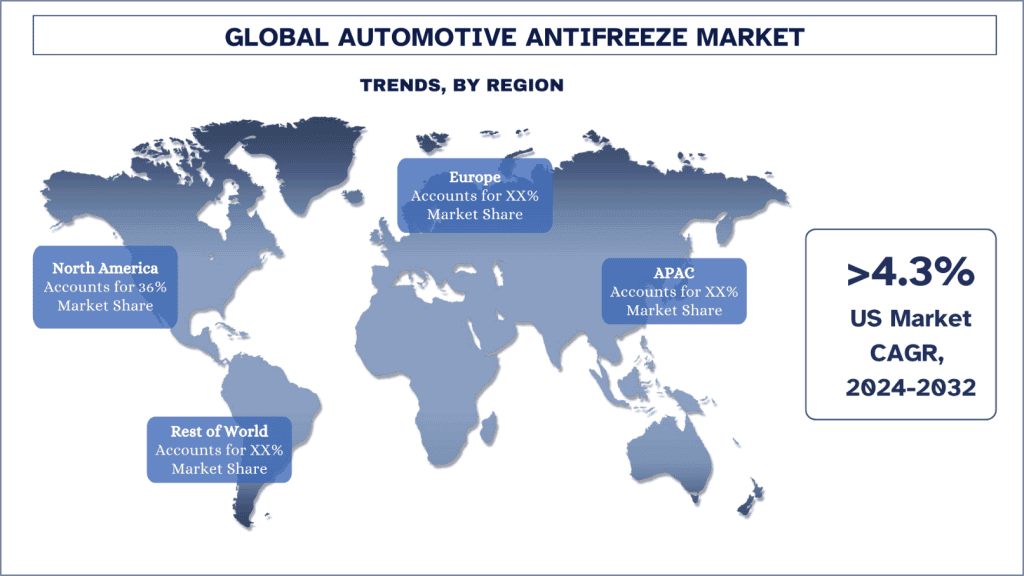
북미가 예측 기간 동안 지배적인 점유율을 차지합니다.
북미 지역의 혹독한 겨울 기후, 특히 미국과 캐나다는 자동차 부동액 제품에 대한 상당한 수요를 창출합니다. 이 지역의 험준한 지형, 잦은 강설, 얼음 도로는 차량에 부동액을 장착하여 차량의 안전하고 효율적인 작동을 보장하는 데 필수적입니다. 또한, 딜러, 소매업체 및 도매업체를 포함한 이 지역의 포괄적인 유통 네트워크는 부동액 제품이 소비자에게 쉽게 제공되도록 보장합니다. 이 광범위한 네트워크는 효율적인 공급망 관리를 가능하게 하여 물류 비용을 절감하고 전반적인 고객 경험을 향상시킵니다.
자동차 부동액 산업 개요
자동차 부동액 시장은 경쟁이 치열하고 분열되어 있으며, 여러 글로벌 및 국제 시장 참여자가 있습니다. 주요 업체들은 파트너십, 계약, 협업, 신제품 출시, 지역 확장 및 인수 합병과 같은 다양한 성장 전략을 채택하여 시장 점유율을 높이고 있습니다. 시장에서 활동하는 주요 업체 중 일부는 Chevron Corporation,Castrol, Exxon Mobil Corporation, Halfords Group, PLC., Prestone Products Corporation, Rock Oil Company LLC., Royal Dutch Shell PLC, TOTAL SA, 및 Valvoline Inc.입니다.
자동차 부동액 시장 뉴스
2023년 11월: Arteco NV는 아시아 시장에 서비스를 제공하는 능력을 향상시키기 위해 중국에 새로운 생산 공장을 건설할 계획을 발표했습니다.
2024년 4월: Schaeffler Automotive Aftermarket Korea는 엔진 열 관리를 최적화하기 위해 상용차용 특수 냉각수인 ‘Schaeffler TruPower’를 출시했습니다.
2023년 1월: Plastic Omnium은 조명을 통합하고 OEM의 증가하는 요구 사항을 충족하는 차별화된 제안을 제공하기 위해 AMLS 및 Varroc Lighting Systems를 인수했습니다.
자동차 부동액 시장 보고서 범위
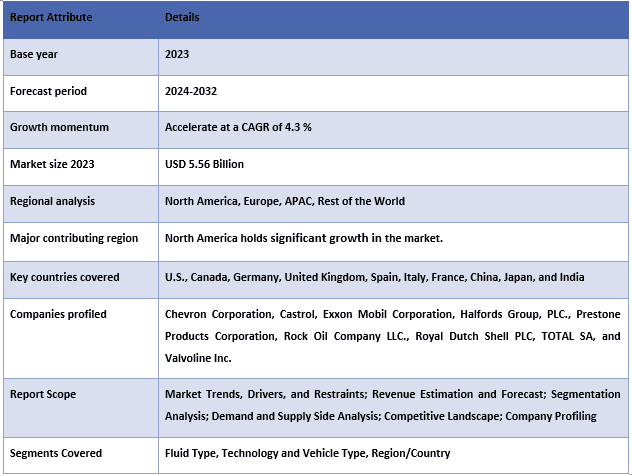
이 보고서를 구매해야 하는 이유:
- 이 연구에는 인증된 주요 산업 전문가가 검증한 시장 규모 측정 및 예측 분석이 포함됩니다.
- 이 보고서는 전체 산업 성과를 간략하게 검토합니다.
- 이 보고서는 주요 비즈니스 재무, 제품 포트폴리오, 확장 전략 및 최근 개발에 중점을 두고 주요 산업 관련 업체의 심층 분석을 다룹니다.
- 산업에 만연한 동인, 제약, 주요 추세 및 기회에 대한 자세한 검토.
- 이 연구는 다양한 세그먼트를 통해 시장을 포괄적으로 다룹니다.
- 산업에 대한 심층적인 지역별 분석.
사용자 정의 옵션:
글로벌 자동차 부동액 시장은 요구 사항이나 기타 시장 부문에 따라 추가로 사용자 정의할 수 있습니다. 이 외에도 UMI는 귀하의 고유한 비즈니스 요구 사항을 이해하므로 귀하의 요구 사항에 완벽하게 맞는 보고서를 얻기 위해 언제든지 문의하십시오.
목차
자동차 부동액 시장 분석 (2024-2032)에 대한 연구 방법론
과거 시장 분석, 현재 시장 추정, 글로벌 자동차 부동액 시장의 미래 시장 예측은 주요 지역에서 자동차 부동액의 채택을 만들고 분석하기 위해 수행된 세 가지 주요 단계였습니다. 과거 시장 데이터를 수집하고 현재 시장 규모를 추정하기 위해 광범위한 2차 연구가 수행되었습니다. 둘째, 이러한 통찰력을 검증하기 위해 수많은 발견과 가정이 고려되었습니다. 또한 글로벌 자동차 부동액 시장의 가치 사슬 전반에 걸쳐 업계 전문가들과 광범위한 1차 인터뷰도 수행되었습니다. 1차 인터뷰를 통해 시장 데이터를 가정하고 검증한 후, 전체 시장 규모를 예측하기 위해 상향식/하향식 접근 방식을 사용했습니다. 그 후, 시장 분석 및 데이터 삼각 측량 방법을 채택하여 산업의 세그먼트 및 하위 세그먼트의 시장 규모를 추정하고 분석했습니다. 자세한 방법론은 아래에 설명되어 있습니다.
과거 시장 규모 분석
1단계: 2차 소스의 심층 연구:
자동차 부동액 시장의 과거 시장 규모를 얻기 위해 연례 보고서 및 재무 제표, 실적 발표, 보도 자료 등과 같은 회사 내부 소스 및 저널, 뉴스 및 기사, 정부 간행물, 경쟁사 간행물, 부문 보고서, 타사 데이터베이스를 포함한 외부 소스에서 자세한 2차 연구를 수행했습니다.,및 기타 신뢰할 수 있는 간행물.
2단계: 시장 세분화:
자동차 부동액 시장의 과거 시장 규모를 확보한 후, 주요 지역별 세분 시장 및 하위 세분 시장에 대한 과거 시장 통찰력 및 점유율을 수집하기 위해 상세한 2차 분석을 수행했습니다. 주요 세분 시장은 유체 유형, 기술 및 차량 유형으로 보고서에 포함되었습니다. 또한 해당 지역의 테스트 모델 전반적인 채택을 평가하기 위해 국가별 분석을 수행했습니다.
3단계: 요인 분석:
다양한 세분 시장 및 하위 세분 시장의 과거 시장 규모를 확보한 후, 자동차 부동액 시장의 현재 시장 규모를 추정하기 위해 상세한 요인 분석을 수행했습니다. 또한 자동차 부동액 시장의 유체 유형, 기술 및 차량 유형과 같은 종속 및 독립 변수를 사용하여 요인 분석을 수행했습니다. 글로벌 자동차 부동액 시장 부문에서 주요 파트너십, 합병 및 인수, 사업 확장 및 제품 출시에 대한 철저한 분석을 수행했습니다.
현재 시장 규모 추정 및 예측
현재 시장 규모 측정:위의 3단계에서 얻은 실행 가능한 통찰력을 바탕으로, 우리는 현재 시장 규모, 글로벌 자동차 부동액 시장의 주요 업체 및 세분 시장의 시장 점유율에 도달했습니다. 필요한 모든 비율 점유율 분할 및 시장 분석은 위에서 언급한 2차 접근 방식을 사용하여 결정되었으며 1차 인터뷰를 통해 검증되었습니다.
추정 및 예측:시장 추정 및 예측을 위해, 이해 관계자에게 제공되는 동인 및 추세, 제약 및 기회를 포함한 다양한 요인에 가중치가 할당되었습니다. 이러한 요인을 분석한 후, 주요 시장 전반에서 다양한 세분 시장 및 하위 세분 시장에 대한 2032년 시장 예측을 도출하기 위해 상향식/하향식 접근 방식과 같은 관련 예측 기술이 적용되었습니다. 시장 규모를 추정하기 위해 채택된 연구 방법론은 다음과 같습니다.
- 수익(USD) 측면에서 업계의 시장 규모와 주요 국내 시장 전반의 자동차 부동액 시장 채택률.
- 모든 시장 세분 시장 및 하위 세분 시장의 비율 점유율, 분할 및 분석
- 제공되는 제품 측면에서 글로벌 자동차 부동액 시장의 주요 업체. 또한 빠르게 성장하는 시장에서 경쟁하기 위해 이러한 업체가 채택한 성장 전략.
시장 규모 및 점유율 검증
1차 연구:주요 지역 전반의 최고 경영진(CXO/VP, 영업 책임자, 마케팅 책임자, 운영 책임자, 지역 책임자, 국가 책임자 등)을 포함한 주요 의견 리더(KOL)와의 심층 인터뷰가 진행되었습니다. 1차 연구 결과는 요약되었고, 명시된 가설을 증명하기 위해 통계 분석이 수행되었습니다. 1차 연구의 입력은 2차 결과를 통합하여 정보를 실행 가능한 통찰력으로 전환했습니다.
다양한 지역의 1차 참여자 분할
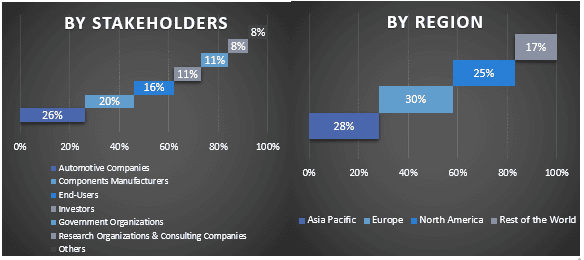
시장 엔지니어링
데이터 삼각 측량 기술은 전체 시장 추정을 완료하고 글로벌 자동차 부동액 시장의 각 세분 시장 및 하위 세분 시장에 대한 정확한 통계 수치에 도달하는 데 사용되었습니다. 데이터는 글로벌 자동차 부동액 시장의 유체 유형, 기술 및 차량 유형에서 다양한 매개변수와 추세를 연구한 후 여러 세분 시장 및 하위 세분 시장으로 분할되었습니다.
글로벌 자동차 부동액 시장 연구의 주요 목적
글로벌 자동차 부동액 시장의 현재 및 미래 시장 동향은 연구에서 정확히 밝혀졌습니다. 투자자는 연구에서 수행된 정성적 및 정량적 분석을 바탕으로 투자를 위한 판단의 근거가 되는 전략적 통찰력을 얻을 수 있습니다. 현재 및 미래 시장 동향은 지역 수준에서 시장의 전반적인 매력을 결정하여 산업 참여자가 미개척 시장을 활용하여 선점 이점을 얻을 수 있는 플랫폼을 제공했습니다. 연구의 다른 정량적 목표는 다음과 같습니다.
- 가치(USD) 측면에서 자동차 부동액 시장의 현재 및 예측 시장 규모와 다양한 세분 시장 및 하위 세분 시장의 현재 및 예측 시장 규모를 분석합니다.
- 연구의 세분 시장에는 유체 유형, 기술 및 차량 유형 영역이 포함됩니다.
- 자동차 부동액에 대한 규제 프레임워크의 정의 및 분석
- 다양한 중개인의 존재와 관련된 가치 사슬을 분석하고, 업계의 고객 및 경쟁사 행동을 분석합니다.
- 주요 지역에 대한 자동차 부동액 시장의 현재 및 예측 시장 규모를 분석합니다.
- 보고서에서 연구된 주요 지역 국가는 아시아 태평양, 유럽, 북미 및 기타 지역을 포함합니다.
- 자동차 부동액 시장의 회사 프로필과 빠르게 성장하는 시장에서 생존하기 위해 시장 참여자가 채택한 성장 전략.
- 업계의 심층적인 지역별 분석.
자주 묻는 질문 자주 묻는 질문
Q1: 자동차 부동액 시장의 현재 시장 규모와 성장 잠재력은 무엇입니까?
Q2: 자동차 부동액 시장 성장의 동인은 무엇입니까?
Q3: 차량 유형별로 어떤 세그먼트가 가장 큰 자동차 부동액 시장 점유율을 차지합니까?Q3: 차량 유형별로 어떤 세그먼트가 가장 큰 자동차 부동액 시장 점유율을 차지합니까?
Q4: 자동차 부동액 시장의 새로운 기술 및 추세는 무엇입니까?
Q5: 어떤 지역이 자동차 부동액 시장을 지배할 것입니까?
관련 보고서
이 상품을 구매한 고객님들도 함께 구매하신 상품

